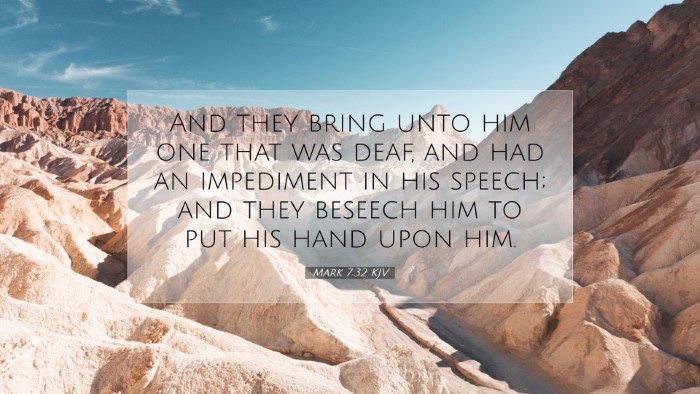Commentary on Mark 7:32
Verse: "And they brought unto him one that was deaf, and had an impediment in his speech; and they beseeched him to put his hand upon him."
Introduction
This verse encapsulates a poignant moment in the ministry of Jesus, where He interacts with a man suffering from deafness and speech impediment. The significance of this miracle lies not only in the physical healing but also in its theological implications regarding Christ's authority, compassion, and the nature of faith.
The Context of the Passage
Mark 7 follows the account of the discussion Jesus has with the Pharisees regarding what truly defiles a person (Mark 7:1-23). This context highlights the contrast between religious formalism and the genuine need of humanity that Christ addresses through miracles. The act of bringing the deaf man to Jesus signifies an expectation of healing and lays the groundwork for understanding the kind of faith that is responsive to Christ’s power.
Historical Background
During the time of Christ, disabilities were often viewed with social stigma. The deaf and those with speech impediments were marginalized, and their conditions were frequently attributed to sin either in themselves or their parents. Thus, the act of bringing such a man to Jesus demonstrates a bold faith, defying societal norms.
Insights from Commentary
-
Matthew Henry
Matthew Henry highlights the compassion of those who brought the man to Jesus. They recognized his suffering and sought help from the only one they believed could heal him. Their action reflects a selfless love that prompts them to intercede for another. Henry suggests that this illustrates the importance of community in faith — we are called to bring those in need before Jesus.
-
Albert Barnes
Albert Barnes emphasizes the physical condition of the man, identifying that he was both deaf and possessed a speech impediment, which rendered him isolated from societal interaction. He notes that this miracle serves as a demonstration of Jesus’ power over physical limitations, but also points to a deeper truth: Jesus comes to ease human suffering. Barnes also remarks on the request made by the crowd, revealing their belief in Jesus' capacity to heal, indicating a level of faith that anticipates divine intervention.
-
Adam Clarke
Adam Clarke discusses the significance of the method by which Jesus healed the man—He put His fingers in the man’s ears and touched his tongue. Clarke notes that these actions symbolize Christ’s intimate involvement with human suffering. Jesus’ use of physical means in the healing demonstrates His willingness to engage with our physical reality. Clarke argues that this physical interaction invites us to consider the nature of faith, which often requires tangible experiences of grace.
Theological Implications
The act of bringing the deaf man to Jesus can be seen as an allegory for sin and its isolating effects. Just as the man could not hear or speak properly, sin distorts our ability to communicate with God and to hear His voice. Jesus' miracle, therefore, signifies not only physical restoration but also spiritual renewal.
Faith in Action
The integrated faith of the individuals who brought the man to Jesus is noteworthy. It raises questions about our own faith: Are we willing to advocate for those who are hurting? Do we recognize the power of Christ to transform lives? Their persistent beseeching for Him to lay His hand on the man is an active demonstration of faith, underscoring that faith often requires action—sometimes on behalf of others.
Conclusion
Mark 7:32 serves as a reminder of Jesus’ profound compassion and the transformative power of His presence. It speaks to both the physical and spiritual healing He offers. For pastors, students, theologians, and scholars, this passage invites deep contemplation on the nature of faith and our human condition. The communal aspect of faith is paramount; we are encouraged to bring others to Christ, believing in His ability to heal and restore.
Reflection Questions
- What does this passage reveal about the nature of faith and community?
- In what ways do we see ourselves reflected in the deaf man or the ones who brought him to Jesus?
- How can we embody this level of advocacy within our communities today?


